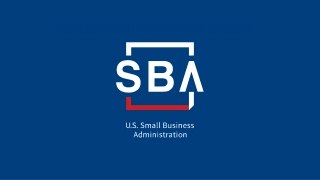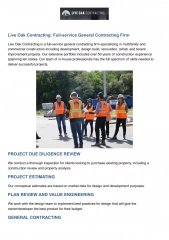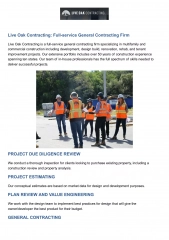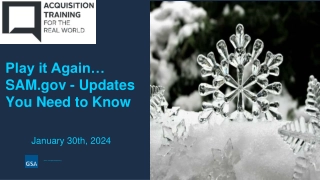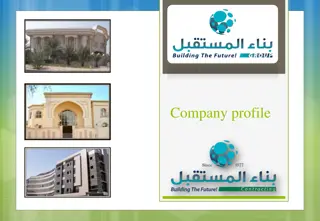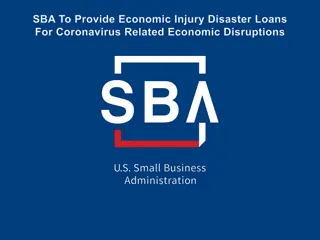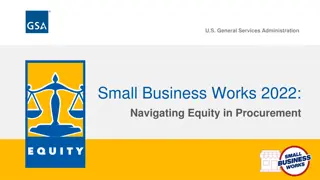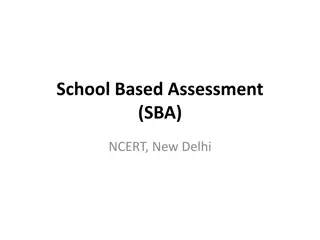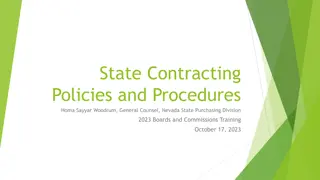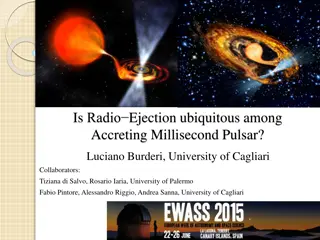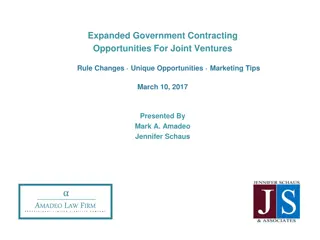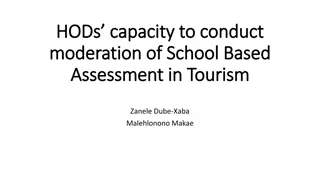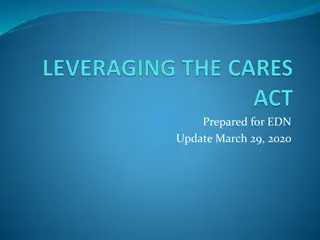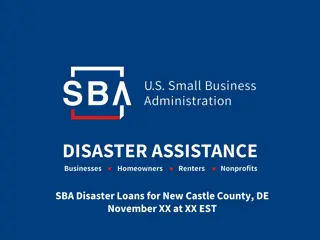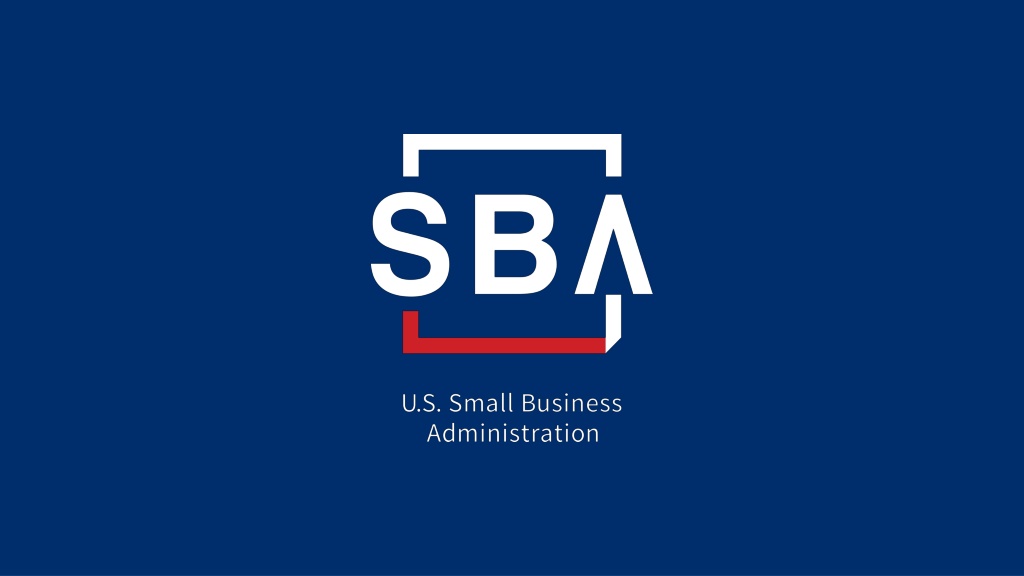
Understanding the HUBZone Program for Small Businesses
Learn about the HUBZone Program by the U.S. Small Business Administration, its purpose to drive federal procurement opportunities to undercapitalized communities, eligibility requirements, and more. Discover how this program supports small businesses in Historically Underutilized Business Zones.
Download Presentation

Please find below an Image/Link to download the presentation.
The content on the website is provided AS IS for your information and personal use only. It may not be sold, licensed, or shared on other websites without obtaining consent from the author. If you encounter any issues during the download, it is possible that the publisher has removed the file from their server.
You are allowed to download the files provided on this website for personal or commercial use, subject to the condition that they are used lawfully. All files are the property of their respective owners.
The content on the website is provided AS IS for your information and personal use only. It may not be sold, licensed, or shared on other websites without obtaining consent from the author.
E N D
Presentation Transcript
Jill Nagy-Reynolds Business Opportunity Specialist SBA Columbus District Office 614-427-1372 jill.nagyreynolds@sba.gov 2
Contracting Incentive The HUBZone Program plays an important role in driving 3% of all federal procurement opportunities to small businesses in undercapitalized communities. 5% Small Disadvantaged Business (SDB) 5% Women-Owned Small Business (WOSB) 3% Service-Disabled Veteran-Owned Business (SDVOSB) 3% Historically Underutilized Business Zone (HUBZone) 3
Relationship Among Small Business Programs (FAR 19.203) SBA s small business socioeconomic programs include: 8(a) Program HUBZone Program Service-Disabled Veteran-Owned (SDVO) Small Business Program Women-Owned Small Business (WOSB) Program There is no order of precedence among these programs In determining which socioeconomic program to use, the contracting officer should consider, at a minimum Results of market research Agency progress in fulfilling small business goals 4
HUBZone Program Purpose Established in 1997, launched in 1999 Fuels growth of small businesses in Historically Underutilized Business Zones (HUBZone) by providing certification for preferential access to federal government contracts. Federal agencies set aside contracts for HUBZone-certified small businesses Small businesses invest in and hire from qualified HUBZones Undercapitalized Communities benefit from job opportunities and investment 5
HUBZone Designations More than 22,000 communities across the country are designated HUBZones. This photo by Unknown Author is licensed under CC BY. 6
Background Information Eligibility Requirements and Program Support
HUBZone Small Business Certification Eligibility Firm must: Be small, by reference to small business size standards; Be at least 51% owned by U.S. citizens, an Indian Tribal Government, an Alaska Native Corporation (ANC), a Native Hawaiian Organization (NHO), a Community Development Corporation, or an agricultural cooperative; Have its principal office the single location at which the greatest number of its employees perform most of their work located in a HUBZone; and Have at least 35% of its employees HUBZone residents. 8
HUBZone Certification Application Process *Submissions are not considered an application until ALL required documents have been received.* 9
Procurement Tips for HUBZone Firms 1. Get up to speed: Start with a visit to the SBA website for tutorials, referrals and information. Get Help: Reach out to a Resource Partner for help (PTAC, SBDC, WBC, SCORE, VBOC, District Office). Do Your Homework: Learn about the opportunities and consider starting with Government purchase card orders, Subcontracting, and Joint Ventures to gain experience. Secure a Mentor: All Small Mentor Prot g Program offers HUBZone firms an opportunity to develop their government contracting capabilities by entering a formal Mentor Prot g Partnership with an experienced government contractor. Leverage your small business status: If you are SDB or DSVOSB or WOSB consider gaining HZ status; already in a HZ get certified! 2. 3. 4. 5. 10
HUBZone Help For support with government contracting and growing your business visit one of SBA s resource partners (SCORE, SBDCs, WBC, VBOC, and PTAC): https://www.sba.gov/local- assistance For support with your HUBZone application: Visit the HUBZone website: sba.gov/hubzone View location eligibility: maps.certify.sba.gov/hubzone/maps Email our Help Desk with specific questions: hubzone@sba.gov Call our staff via our weekly conference call every Thursday at 2pm ET: 202-765-1264; Access code: 63068189# 11
Program Changes Related to Rule Change
HUBZone Program Challenges Instability regarding geographic eligibility (i.e. maps changed too often which served as a disincentive to investment in HZ communities) Confusing and burdensome requirements for maintaining certification Lengthy and cumbersome application and recertification processes Small businesses found the program difficult Federal Agencies failed to meet 3% goal Difficulty finding qualified HUBZone firms who could maintain eligibility A unique and arduous requirement to verify eligibility twice (which lengthened the procurement process for HZ firms and served as a disincentive) Communities experienced mixed results The fluidity of the program made it difficult for communities to leverage Eligibility requirements that failed to recognize the unique characteristics of rural distress may have neglected some deserving communities from participation 13
Improve the customer experience HUBZone Program Changes Expand and stabilize the HUBZone footprint Increase program utilization 14
Faster Certification: within 60 days of a complete submission Improve the Customer Experience Streamlined Platform: Transitioning to a user-friendly interface. Early Support: Expansion of Early Engagement Initiative 15
STABILIZE THE MAPS Expand and Stabilize HUBZone Footprint EXPAND INTO RURAL AREAS RECOGNIZE LONG-TERM INVESTMENT IN COMMUNITIES 16
Maps will be updated every five years Expand and Stabilize HUBZone Footprint, Part 2 Redesignated Areas: Concept Remains three-year transition period for expiring HUBZone Qualified Census Tracts and Qualified Non- metropolitan Counties STABILIZE THE MAPS 17
Expand and Stabilize HUBZone Footprint, Part 3 New category added for Governor-Designated Areas Rural communities of 50,000 or less Unemployment of 120% the state or US average Opportunity Zones encouraged Governors must petition SBA EXPAND INTO RURAL AREAS 18
Expand and Stabilize HUBZone Footprint, Part 4 Small businesses that invest in HUBZones by purchasing a building or entering a long-term lease (of 10 years or more), may maintain HUBZone eligibility for up to 10 years, even if the office location no longer qualifies as a HUBZone. Does not apply to buildings in areas currently categorized as Redesignated Areas RECOGNIZE LONG- TERM INVESTMENT IN COMMUNITIES 19
ANNUAL RECERTIFICATION Increase Program Utilization CONTRACT VERIFICATION AND ELIGIBILITY RESIDENCY REQUIREMENT LEGACY EMPLOYEE 20
Firms must annually recertify. Increase Program Utilization, part 2 Once certified, a firm will be eligible for all HUBZone contracts for which it qualifies as small, for a period of one year from the date of its initial certification or recertification (unless it acquires, is acquired by, or merges with another firm). ANNUAL RECERTIFICATION Full documentation reviews will be required every three years. 21
A firm must be appear in DSBS as HUBZone-certified at the time of offer. Increase Program Utilization, part 3 SBA will determine the eligibility of a concern subject to a HUBZone protest as of the date of its initial certification or its most recent recertification, if applicable. A firm that receives a HUBZone contract must attempt to maintain 35% employment of HUBZone residents. CONTRACT VERIFICATION Attempt to maintain is defined as employing at least 20% HUBZone residents. 22
For HUBZone set-aside MACs, a firm that is HUBZone certified at the time of offer for the MAC will be considered HUBZone-certified for each order issued against the MAC. Increase Program Utilization, part 4 For non-FSS* MACs issued under full and open competition, where the CO sets aside an order for HUBZone firms, an offeror must be HUBZone certified (and so appear in DSBS) at the time it submits its offer for the order. CONTRACT ELIGIBILITY (MULTIPLE AWARD CONTRACTS MACS) For all FSS* MACs, a firm that is HUBZone certified at the time of initial offer for the FSS contract will be considered HUBZone certified for each order issued against the FSS contract. *FSS = Federal Supply Schedule 23
Increase Program Utilization, part 5 An employee who resided in a HUBZone for at least six months at the time of certification or recertification, and continues to reside in a HUBZone for at least six months after, may continue to be considered a HUBZone resident so long as continuously employed by the firm, even if he/she moves to a non-HUBZone area, or if the area of his/her residence loses HUBZone geographical eligibility. RESIDENCY REQUIREMENT LEGACY EMPLOYEE 24
Additional Information Contracting Details
HUBZone Program References Statutory authority: Small Business Act, 15 U.S.C. 632(p), 657a HUBZone Program Regulations: 13 CFR Part 126 Size Regulations: 13 CFR Part 121 Recent rulemakings: Governor-Designated Covered Areas Direct Final Rule: 84 FR 62449 (Nov. 15, 2019) Effective Jan. 1, 2020 HUBZone Program Improvements Final Rule: 84 FR 65239 (Nov. 26, 2019) Effective Dec. 26, 2019 26
HUBZone Contracts (13 CFR 126.600) HUBZone contracts are contracts awarded to certified HUBZone small business concerns, regardless of the place of performance, through any of the following procurement methods: Sole source awards 100% HUBZone set-aside awards and partial set-asides Full and open competition, where the HUBZone price evaluation preference is applied (application of a 10% price evaluation preference applied in full and open competition only applies if initial low offer is from a large business, not if low bidder is a small business) Reserves for HUBZone SBCs under Multiple Award Contracts (MAC) Orders set-aside for HUBZone SBCs against a MAC, where the MAC was awarded in full and open competition 27
HUBZone and Simplified Acquisition (13 CFR 126.607, FAR 19.1305) CO MAY award via HUBZone set-aside or sole source award AT OR BELOW SAT CO shall first consider a set-aside before a HUBZone sole source award or setting aside the requirement as a small business set-aside ABOVE SAT SAT=$250,000 Micro-purchase threshold $10,000 28
HUBZone Sole Source Awards (13 CFR 126.612, FAR 19.1306) CO may award a sole source contract to a HUBZone SBC (before considering a small business set-aside) if CO does not expect to receive offers from at least 2 HUBZone SBCs Anticipated price of the contract (including options) will not exceed $7 M for a requirement assigned a manufacturing NAICS code; or $4 M for all other requirements The requirement is not currently being performed by an 8(a) participant and has not been accepted as an 8(a) requirement by SBA The HUBZone SBC has been determined to be a responsible contractor with respect to performance Award can be made at a fair and reasonable price SBA has the right to appeal CO s decision not to make a HUBZone sole source award Note: This exclusion of FAR 19.1306 was removed: The acquisition is greater than the SAT 29
HUBZone Set-Aside (FAR 19.1305(c)) To award via HUBZone set-aside, CO must have a reasonable expectation that Offers will be received from at least 2 HUBZone SBCs; and Award will be made at a fair market price If the CO receives only one acceptable offer from a certified HUBZone SBC the CO should make an award to that concern no acceptable offers from HUBZone SBCs the CO should withdraw the HUBZone set-aside and set the procurement aside for small business concerns, as appropriate (see FAR 19.203) 30
Set-Aside of Orders A CO may Set-aside an order placed against a multiple-award contract for HUBZone SBCs (FAR 19.5) and no justification for this exception to fair opportunity is required (FAR 16.5) Set-aside part(s) of a multiple-award contract for HUBZone SBCs (FAR 19.5) Reserve one or more contract awards for HUBZone SBCs under full and open multiple-award procurements (FAR 19.5) Set-aside orders & BPAs under the GSA Schedule (FAR 8.4) 31
Set-Aside of Orders FAR Part 19 Applies FAR 16.505(b)(2)(i)(F): When setting aside orders for small business concerns: The specific small business program eligibility requirements identified in part 19 apply. FAR 8.405-5(a)(2): When setting aside orders and BPAs against the GSA Schedule: The specific small business program eligibility requirements identified in part 19 apply. What does this mean? Examples: HUBZone joint venture requirements apply HUBZone limitations on subcontracting apply 32
Price Evaluation Preference (PEP) For HUBZone SBCs (13 CFR 126.613, FAR 19.1307) The HUBZone price evaluation preference (PEP) shall be used in acquisitions conducted using full and open competition The preference shall NOT be used Where price is not a selection factor (e.g.,Architect/Engineer acquisitions) Where all fair and reasonable offers are accepted (e.g.,the award of multiple award schedule contracts) 33
Applying the HUBZone PEP The CO shall apply the HUBZone PEP in F&O competition, when the lowest, responsive, responsible offeror is a large business The PEP is applied by adding a factor of 10% to The otherwise lowest, responsive, responsible offer from a large business (AKA the large business that is the apparent successful offeror) Offers from HUBZone SBCs that have waived the PEP Offers from small business concerns that are not the apparent successful offeror NOTE: Apply PEP first, then do best value analysis 34
Price Evaluation Preference Examples Before PEP applied, the large business is the lowest, responsive and responsible offeror. After applying the 10% PEP, the large business is still the lowest, responsive and responsible offeror. In this example, the application of the PEP does not benefit the HUBZone SBC. NOTE: If price equal Award to the HZ SBC 35
Price Evaluation Preference Examples, part 2 Before PEP applied, the large business is the lowest, responsive and responsible offeror. After applying the 10% PEP, the large business is no longer the lowest, responsive and responsible offeror. In this example, the application of the PEP does benefit the HUBZone SBC. 36
Price Evaluation Preference Examples, part 3 Before PEP applied, the small business is the lowest, responsive and responsible offeror. Since lowest offeror is not a large business, the HUBZone PEP is not applied. 37
Requirements to Bid on HUBZone Contract (13 CFR 126.601) At the time a certified HUBZone SBC submits its initial offer (including price) on a specific HUBZone contract, it must certify to the CO that: It is a certified HUBZone SBC that appears on SBA s List (DSBS) dsbs.sba.gov; It is a small business under the NAICS code assigned to the procurement; and It will attempt to maintain having at least 35% of its employees residing in a HUBZone during the performance of a HUBZone contract. (13 CFR 126.200(e)) It will comply with the applicable limitations on subcontracting during performance of the contract, as set forth in 13 CFR 125.6, 126.200(f) and 126.700. Note: The requirement to notify SBA of a material change was removed with the Regulations published on 12/26/2019. 38
Eligibility Improvements: Attempt to Maintain A firm will be eligible to compete for HUBZone set-aside awards while attempting to maintain compliance with the 35% HZ residency requirement, so long as at least 20% of its employees reside in a HUBZone. HUBZone firms that are performing on a HUBZone contract at the time of their recertification must have at least 20% of their employees residing in a HUBZone to recertify. HUBZone firms that are not performing on a HUBZone contract at the time of recertification must have at least 35% of their employees residing in a HUBZone to recertify. * When firms receive a federal contract they often need to ramp up hiring quickly which in the case of HUBZone threatened to temporarily place them out of compliance with the requirements of the program if fewer than 35% of the workforce did not live in a HUBZone. This change provides clarity regarding the definition of attempting to maintain compliance while performing on a federal contract. 39
Joint Venture A HUBZone SBC may joint venture with one or more other small business concerns or its SBA-approved mentor for the purpose of submitting an offer for a HUBZone contract. (13 CFR 126.616) *Note: The joint venture itself need not be certified as a qualified HUBZone SBC. 40
Limitations on Subcontracting (LOS) Final Rule published at 81 FR 34243 Effective June 30, 2016 A HUBZone SBC prime contractor may subcontract part of a HUBZone contract, provided the HUBZone SBC meets the following requirements: *NOTE: Subcontractors that are also HUBZone SBCs are referred to as similarly situated entities 41
Nonmanufacturer Rule (NMR)(13 CFR 126.601, FAR 19.1303) A HUBZone SBC may submit an offer for supplies as a nonmanufacturer if it meets the requirements of the NMR set forth at 13 CFR 121.406(b)(1) In 2016, SBA eliminated the requirement that the manufacturer also be a HUBZone SBC (81 FR 34243) Under SBA regulations, a CO may now request a waiver of the NMR for a HUBZone contract Class waivers also apply to HUBZone contracts As a result, the HUBZone program s treatment of the NMR is now consistent with SBA s other socioeconomic programs 42
Questions? Jill Nagy-Reynolds Business Opportunity Specialist SBA Columbus District Office 614-427-1372 jill.nagyreynolds@sba.gov 43

